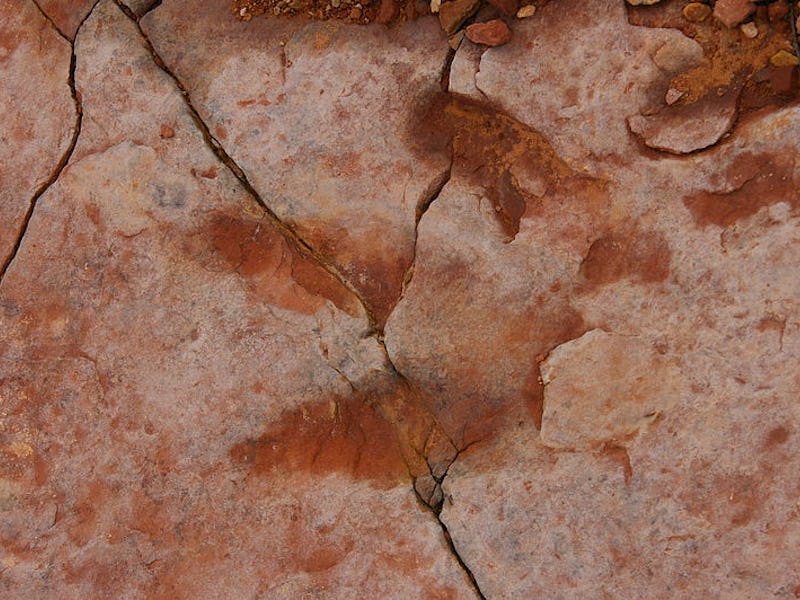Utah's Stone-Throwing Tourists are Accidentally Destroying Dinosaur Relics
Our only traces of Dilophosaurus are sinking into a lake.

There’s something deeply satisfying about throwing stones. Skipping pebbles across a still pond brings peace like nothing else. Mountain top? Toss a rock into the abyss — you earned it. Bet you can’t hit that tree from here, but I know you’ll try anyway. We were all kids once; maybe we all still are.
But even the most innocent urges can have disastrous consequences. Take, for example, the tourists at the Red Fleet State Park in Utah, who, as The Salt Lake Tribune reported last week, have been satisfying their rock-throwing urges by dislodging bits of sandstone and tossing them into a nearby lake. The problem is that the park isn’t home to just any sandstone. These ancient sedimentary beds hold priceless dinosaur footprints made by the three-toed, 20-foot-tall Dilophosaurus, about 193 million years ago.
Dilophosaurus fossils aren't easily preserved in the sandstone where they lived and died, but their footprints remain.
“It’s become quite a big problem,” Utah Division of State Parks spokesman Devan Chavez told The Salt Lake Tribune. “They’re just looking to throw rocks off the side. What they don’t realize is these rocks they’re picking up, they’re covered in dinosaur tracks.” Fragments of stone bearing these prints now sit at the bottom of Red Fleet Reservoir, where they might have shattered, or worse, dissolved. They’re precious enough that the park is considering deploying a team of divers to recover what’s left of the stones.
While it may seem like an innocent enough mistake — who really checks a rock before it’s thrown? — the signs at the park make it clear. Don’t touch the damn sandstone.
The red sandstone of Red Fleet State Park holds many Dilophosaurus footprints, but these stones can dissolve when thrown into water.
More protection for these relics is necessary; there aren’t that many of them, and they’re our best bet for learning more about these early Jurassic raptors. As Smithsonian pointed out in 2012, the orange sandstone of Utah where these prints are found isn’t particularly good at preserving whole-body fossils, but it holds prints exceptionally well. Few skeletons have ever been found, but the first was documented in 1942 in Arizona after Jesse Williams, a Navajo man who had found the bones two years prior, showed them to researchers from the University of California Museum of Paleontology.
The dinosaur was given the name Dilophosaurus, which means “two-crested lizard,” to describe the two crests of bone on either side of its head. Scientists have since deduced that it was a predator and that it grew to be as long as a giraffe is tall, but it remains mysterious in many ways, despite the fact that it’s become emblematic of predators from the early Jurassic era.
Its fame is largely due to the fact that it played a crucial role in the classic film Jurassic Park, where it was incorrectly depicted as a 4-foot-tall, double-frilled, venom-spitting machine. Remember the iconic scene where Dennis Nedry gets devoured alive after his foolish attempt to hide in a Jeep goes awry? That’s all Dilophosaurus, baby — or, at least, a dinosaur inspired by the real thing.
Perhaps acknowledging the dinosaur’s role in this beloved childhood film would be the best way for Red Fleet to appeal to the hearts of its destructive stone-throwers. They, like the paleontologists, are just trying to preserve remnants of the past.